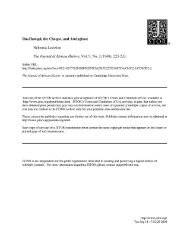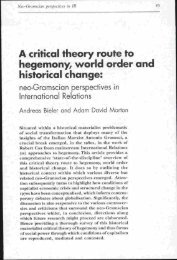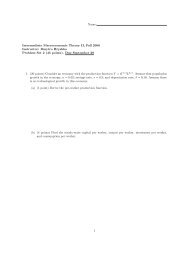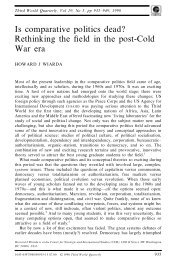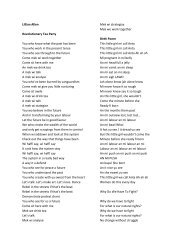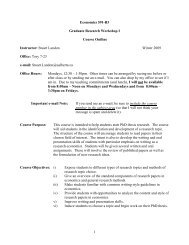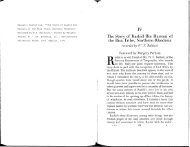personal memories revolutionary states and indian ocean migrations
personal memories revolutionary states and indian ocean migrations
personal memories revolutionary states and indian ocean migrations
You also want an ePaper? Increase the reach of your titles
YUMPU automatically turns print PDFs into web optimized ePapers that Google loves.
necessarily partial <strong>and</strong> provisional<br />
response to 11 September... A response<br />
to these events can <strong>and</strong> should be based<br />
not on supposedly distinct cultural or<br />
civilizational values, but on an<br />
internationalist approach...” (p. 27).<br />
Readers familiar with Halliday’s past<br />
work, particularly Islam <strong>and</strong> the Myth of<br />
Confrontation (I.B. Tauris & Co. Ltd,<br />
1995), will underst<strong>and</strong> Halliday’s<br />
fundamental theses that conflicts<br />
between the Islamic <strong>and</strong> Western worlds<br />
are neither a necessity, nor a function of<br />
the peculiarities of those two societies.<br />
In fact, Halliday correctly asserts the<br />
absence of a unitary Islamic world or a<br />
unified West, capable of having a single<br />
conflict-ridden relationship. Rather, the<br />
conflicts between Islamic <strong>and</strong> Western<br />
societies may be studied using the same<br />
approaches as any other conflicts.<br />
After a review of his<br />
approach—including a deliberate<br />
admonition for the intellectual to<br />
exercise responsibility, rather than to<br />
inflame <strong>and</strong> profit from conflict—<br />
Halliday begins his discussion of the 11<br />
September attacks by asserting they<br />
were the latest battle of a long-running<br />
conflict, “A battle, global in intent <strong>and</strong><br />
extent, was joined well before 11<br />
September 2001. Its course is by no<br />
means certain.” (p. 29) In his first<br />
chapter, he identifies historical <strong>and</strong><br />
conjunctural causes for the 11<br />
September attacks. The historical<br />
causes fall into two broad categories:<br />
Long-term antecedents <strong>and</strong> immediate<br />
causes. The former include the<br />
Crusades by Western Christians on the<br />
Muslim Middle East that began in the<br />
late 11 th century; the expulsion of the<br />
Arabs/Muslims from Spain, completed<br />
in 1492; <strong>and</strong> the Islamic concept of<br />
Jihad, literally exertion, or mobilization<br />
for the faith, which has acquired the<br />
popular interpretation of literal (holy)<br />
war.<br />
Halliday identifies three<br />
immediate historical causes for the 11<br />
September attacks: the legacy of<br />
colonialism, the Cold War, <strong>and</strong><br />
100<br />
economic globalization. Colonialism<br />
(ending circa 1945) left a series of<br />
unresolved issues in the Middle East,<br />
causing generalized resentment of the<br />
West. The Cold War between a US-led<br />
West <strong>and</strong> a Soviet-led East (1945-90)<br />
made Afghanistan its last battlefield,<br />
resulting in a US-supported call to<br />
Muslims worldwide to fight Soviet<br />
“infidels,” ultimately leading to the<br />
Taliban government, <strong>and</strong> its policies<br />
enabling the emergence of Osama bin<br />
Laden <strong>and</strong> the institutionalization of the<br />
al-Qa`ida network. The movement<br />
toward economic globalization is the<br />
seminal outcome of the end of the Cold<br />
War; its attendant inequities amplify<br />
existing resentments.<br />
The conjunctural causes of 11<br />
September, Halliday stipulates, are based<br />
in a “Greater West Asian Crisis” with<br />
three general features. The first is the<br />
new pattern of linkages between<br />
previously separate conflicts, such as the<br />
political <strong>and</strong> rhetorical linkage of the<br />
Palestinian-Israeli conflict to regional<br />
crises as diverse as the 1973 oil<br />
embargo, the Lebanese civil war that<br />
erupted in 1975, the 1979 Iranian<br />
Revolution, Iraq’s 1990 invasion of<br />
Kuwait, <strong>and</strong> Osama bin Laden’ call for<br />
jihad against the West. The second<br />
conjunctural cause is the crisis of the<br />
state in West Asia, where nationalists or<br />
Islamists are seeking to take power away<br />
from those who control the state, using<br />
terrorist tactics. Halliday highlights bin<br />
Laden’s use of the Quranic term<br />
“hypocrite” (munafiq) to denote Muslim<br />
leaders <strong>and</strong> regimes who appear to back<br />
the cause of Islam, but do not; they <strong>and</strong><br />
their association with the US are,<br />
according to Halliday, the principal<br />
targets of 11 September. He points out<br />
that al-Qa`ida emerged <strong>and</strong> succeeded in<br />
places where the state was particularly<br />
weak. Sudan, Afghanistan <strong>and</strong>, most<br />
recently, Yemen are the best examples.<br />
The third feature of the West Asian<br />
crisis is the emergence of a<br />
transnational, fundamentalist, <strong>and</strong><br />
militant Islamism, based on the<br />
Vol. 5, Fall 2005, © 2005 The MIT Electronic Journal of Middle East Studies



